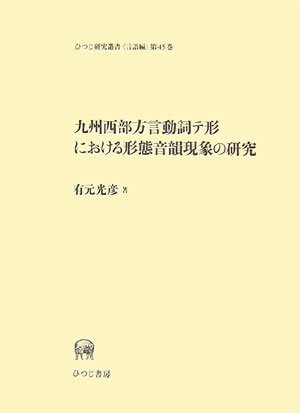7 0 0 0 OA 中国地方方言における伝播の整流と偏流
中国地方方言は、西日本方言の広がりにおいてそれを促進する役目をもつのか、妨げ停滞させる役目をもつのか。たとえば断定辞は中世のデアからヂャ・ジャをへてヤへ変化する流れがあり、それは現在の方言分布状況と一致する。この流れで中国地方はジャからヤへ移行するかとみると、九州がその動きを速く見せるのに比して、ここではそれが遅い。そのような変化と伝播の「淀み」の成因を明らかにし、ひいては日本語方言状況の成立において中国地方方言がどのように位置付けられるかを明らかにすることの基礎研究たらんとし、東西・南北・円環のうち東西山間部・沿岸部の2経路においてどのような伝播の速度差があるかを追跡した。
4 0 0 0 IR 伝言ゲームの言語学的分析
- 著者
- 有元 光彦
- 出版者
- 梅光学院大学
- 雑誌
- 日本文学研究 (ISSN:02862948)
- 巻号頁・発行日
- vol.31, pp.A25-A35, 1996-01-20
- 著者
- 有元 光彦
- 出版者
- 山口大学教育学部
- 雑誌
- 研究論叢. 第1部・第2部, 人文科学・社会科学・自然科学 (ISSN:1349810X)
- 巻号頁・発行日
- vol.62, pp.37-55, 2012
1 0 0 0 IR 天草諸島方言の多様性 : 御所浦島方言・獅子島方言の動詞テ形音韻現象
- 著者
- 有元 光彦
- 出版者
- 山口大学教育学部
- 雑誌
- 研究論叢. 第1部・第2部, 人文科学・社会科学・自然科学 (ISSN:1349810X)
- 巻号頁・発行日
- vol.64, pp.31-46, 2014
1 0 0 0 OA 九州方言における動詞テ形の音韻規則(<特集>九州諸方言の音声)
- 著者
- 有元 光彦
- 出版者
- 日本音声学会
- 雑誌
- 音声研究 (ISSN:13428675)
- 巻号頁・発行日
- vol.5, no.3, pp.19-26, 2001-12-31 (Released:2017-08-31)
The te-form verbs in the (West-)Kyushu dialects have a characteristic behavior in the verb conjugation system, which we call the "te-form phenomenon". This phonological phenomenon is that so-called SOKU-ON or HATSU-ON appears, corresponding to te in the standard dialect. This phenomenon depends on the difference of the stem-final segment. The te-form phenomenon is different across dialects. We assume that the e-deletion rule is the core of four rules governing this phenomenon. Differences of dialects are reflected in the applicational environment of the e-deletion rule. In addition, we discovered a "pseudo te-form phenomenon", which is partially similar to te-form phenomenon.
1 0 0 0 IR 西日本方言話者の用いる「クナイ」について
- 著者
- 黒崎 貴史 有元 光彦
- 出版者
- 山口大学教育学部
- 雑誌
- 山口大学教育学部研究論叢 = Bulletin of the Faculty of Education, Yamaguchi University (ISSN:24333670)
- 巻号頁・発行日
- vol.70, pp.273-282, 2021-01
1 0 0 0 IR 熟議を利用した新語形成メカニズムについて : 「観察型」と「共感型」という視点
- 著者
- 黒﨑 貴史 有元 光彦
- 出版者
- 山口大学教育学部
- 雑誌
- 山口大学教育学部研究論叢 = Bulletin of the Faculty of Education, Yamaguchi University (ISSN:24333670)
- 巻号頁・発行日
- vol.68, pp.325-334, 2019-01
1 0 0 0 OA 九州方言におけるテ形音韻現象の崩壊について
- 著者
- 有元 光彦
- 出版者
- 日本言語学会
- 雑誌
- 言語研究 (ISSN:00243914)
- 巻号頁・発行日
- vol.158, pp.1-28, 2020 (Released:2021-02-16)
- 参考文献数
- 12
本稿の目的は,九州方言に広く起こるテ形音韻現象を対象とし,そこで分類される様々な方言タイプのバリエーション間に,どのような相関関係があるのかについて考察することにある。従来の研究で提案されていた「非テ形現象化」を分節音レベルで再検討し,それを「方言システムの崩壊」という新たな概念の中で位置づける。そして,テ形音韻現象の中で仮定されていたe消去ルール・e/i交替ルールの適用範囲が狭くなる方向への体系的な変化,特に非適用環境に関して「特殊から一般へ」の変化が起こっていることを明らかにする。また,地理的には,真性テ形現象方言が「五島列島→天草→熊本県南部」という順の崩壊プロセスをとるだけでなく,擬似テ形現象方言も「天草→熊本県北東部・大分県北西部」という崩壊プロセスをとる。異なる地域であっても,方言タイプにおいては同様の崩壊プロセスが起こっていることが明らかとなった。さらに,理論的には,崩壊プロセスが周圏性によって裏付けられることを示した。
1 0 0 0 九州西部方言動詞テ形における形態音韻現象の研究
1 0 0 0 「海の道」仮説と群仮説 : 九州西部方言・出雲方言の音韻現象
- 著者
- 有元 光彦
- 出版者
- 山口大学
- 雑誌
- 研究論叢. 自然科学 (ISSN:05131693)
- 巻号頁・発行日
- vol.54, no.1, pp.59-67, 2004-12-20
- 著者
- 有元 光彦
- 出版者
- 日本音声学会
- 雑誌
- 音声研究 (ISSN:13428675)
- 巻号頁・発行日
- vol.5, no.3, pp.19-26, 2001-12
The te-form verbs in the (West-)Kyushu dialects have a characteristic behavior in the verb conjugation system, which we call the "te-form phenomenon". This phonological phenomenon is that so-called SOKU-ON or HATSU-ON appears, corresponding to te in the standard dialect. This phenomenon depends on the difference of the stem-final segment. The te-form phenomenon is different across dialects. We assume that the e-deletion rule is the core of four rules governing this phenomenon. Differences of dialects are reflected in the applicational environment of the e-deletion rule. In addition, we discovered a "pseudo te-form phenomenon", which is partially similar to te-form phenomenon.
